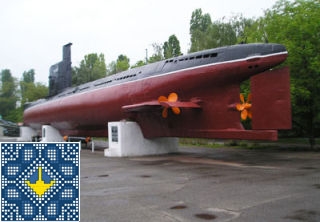|
Odessa Sights | 411th Coastal Battery and Submarine A615 "Baby" (Quebec) Individual and group tours to Odessa |
The whole structure of 411th Coastal Battery was built by two-thousand people under control of Department of Hard Labor, Civil Engineering Office of Naval Forces and NKVD. For the formation of concrete slabs used concrete M600 and pebbles. Next to each concrete mixer was an officer of People's Commissariat of Internal Affairs which monitors all components in the formation of concrete mortar. During the construction taken into account the large margin of safety of 411th Coastal Battery for different combat missions. Bunkers girded with a double layer of armored steel thickness of 30 mm and the thickness of concrete reached 75 cm to 1 meter. 411th Coastal Battery consisted of command post, artillery yards with underground casemates and power plant. The command post was located on the shore of Gulf of Odessa at a distance of 750 meters from the main position at a depth of 10 meters with connecting tunnel at a depth of 18 meters. The upper section of command post consisted of cylindrical armored cap. Power plant was built to the southeast of artillery yards. Inside the bunker at a depth of 10 to 23 meters were boiler "Strela (Boom)", three diesel engines of 105 horsepower each, generator for household needs. Underground storages included large tanks for fuel, lubrication materials and water tanks of one thousand cubic meters each. 411th Coastal Battery supplied with water from artesian springs from a depth of 30 meters so the battery had an independent way of obtaining drinking water. Water supply was carried out by a centrifugal pump of fire pumping system. The gun positions consisted of three deep concrete artillery yards. In the center of each of them housed one 180-mm naval coastal gun installed in the tower that hinged for circular firing with total weight of 160 tons. Under the reinforced concrete floor located mechanisms of obtain instructions from command center, electric swinging mechanism of the tower, chemical defense system. From the depths of underground artillery yards came two vertical feeders with ammunition. Each cannon-shot for 180-mm naval coastal gun weighed 97,5 kg. By the entrance hole outside air came to the room of chemical protection for filtration. Next followed a vestibule with a cover of the armored door thickness of 75 mm. In the underground corridor were room of chemical protection, sanitary unit, boiler, shower, ventilation slots. On the depth of 23 meters was a tunnel that connected positions of 180-mm naval coastal guns. In the tunnel were power cables, fire control, lighting, communications, pipes of hot and cold water. Also so deep underground were living rooms for gun crew soldiers. In case of chemical attack ventilation system has created excessive air pressure of 0,2 atmospheres which excluded the penetration of external oxygen with toxic substances inside of underground structures of 411th Coastal Battery. Artillery yards were covered by camouflage nets and after the firing - position was closed by large flaps with camouflage as village house with plantings of vines and small trees. At 700 meters from 411th Coastal Battery there was false pasition of battery with wooden models of guns with sand tracks. This provided a total immunity of enemy aircraft attacks which bombarded the false target. In addition to 356 soldiers of the battery itself there was anti-aircraft platoon of 45 mm cannons (three cannons) and anti-aircraft guns "Maxim" which formed the cover defense. The first combat of 411th Coastal Battery started at 09:00 on August 5, 1941 when was received information about a cluster of large forces of 4th Romanian Army near Akkerman fortress. The battery commander Ivan Nikitenko was ordered to destroy the enemy group. When first 180-mm high-explosive cannon-shots reached the target - the enemy just panicked thinking that it was Soviet air force bombs and opened fire from all weapons into the air. Soviet artillery continued shooting causing considerable damage to the enemy. For 73 days of Odessa Defense 411th Coastal Battery made 220 firings: on the accumulation of manpower and equipment - 180 times, control centers - 24 times, artillery - 16 times using up to 2 119 cannon-shots of armor-piercing and high-explosive impact. The enemy has experienced the destructive force of 200 tons of deadly metal and suffered heavy losses. It should be mentioned that enemy ships was not made a single shot because of lack of naval forces in Black Sea in the early months of World War II. At night on October 16, 1941 411th Coastal Battery covered the retreat of Maritime Army units from Odessa to Sevastopol firing in the short time of 230 cannon-shots. Then by order of command the battery was blown up and personnel were shipped to rearward. On 9th of May 1975 was opened Memorial "Heroic Defense of Odessa 1941" which is based on the former position of 411th Coastal Battery. In 1983 director of the memorial Alexander Rysin managed by Ministry of Defense to deliver to Odessa 180-mm naval gun same type that was in the battary. The transportation was done by four large railway platforms from the port of Sovetskaya Gavan in Far East to Odessa. The 180-mm naval gun was installed on site of previous 130-mm gun D-13 by 250-ton crane. The positions of the first and third artillery yards remained intact. Submarine A615 "Baby" (Quebec) Monument to Submarine A615 "Baby" (Quebec) is set on 1st of March 1980 in Odessa Memorial "Heroic Defense of Odessa 1941". Submarine A615 "Baby" (Quebec) - small Soviet submarine (NATO classification - Quebec). Submarines of project A615 are the only in the world history able to move under the water on diesel engine without a snorkel. The main feature of these small submarines were air independent engines for underwater travel. The main engine was diesel 32D which had 900 horsepower. Two diesel engines of M50P of 700 horsepower intended for the forced modes. For moving under water by diesel engines the submarine was equipped with two tanks with liquid oxygen of 8,5 tons and 14,4 tons of chemical lime absorber. There was also an electric motor PG-106 of 100 horsepower. Durable hull of Submarine A615 "Baby" (Quebec) was divided into seven compartments by transverse bulkheads. The transverse bulkhead of central post (third compartment) calculated on the pressure of 10 kgs/cm2, the rest of bulkheads - 1 kg/cm2. In total from 1953 to 1959 was released 29 submarines of A615 project. Submarine A615 "Baby" (Quebec) had bad reputation because of high risk of fire and got the nickname "Lighter". In 1960s has increased the importance of quietness of underwater moving so in the early 70s submarines of A615 project were taken out of Soviet Navy. To date survived two copies of Submarine A615 "Baby" (Quebec). The submarine M-296 exhibited under the designation M-305 is installed in Odessa and submarine M-26 - in Krasnodar. You could visit 411th Coastal Battery and Submarine A615 Baby (Quebec) with Ukraine Tour South Ring |

Book your tour or request information: |
|
- please, look at reviews of tourists about our tours
|
© 2011 - 2025 All rights reserved |


